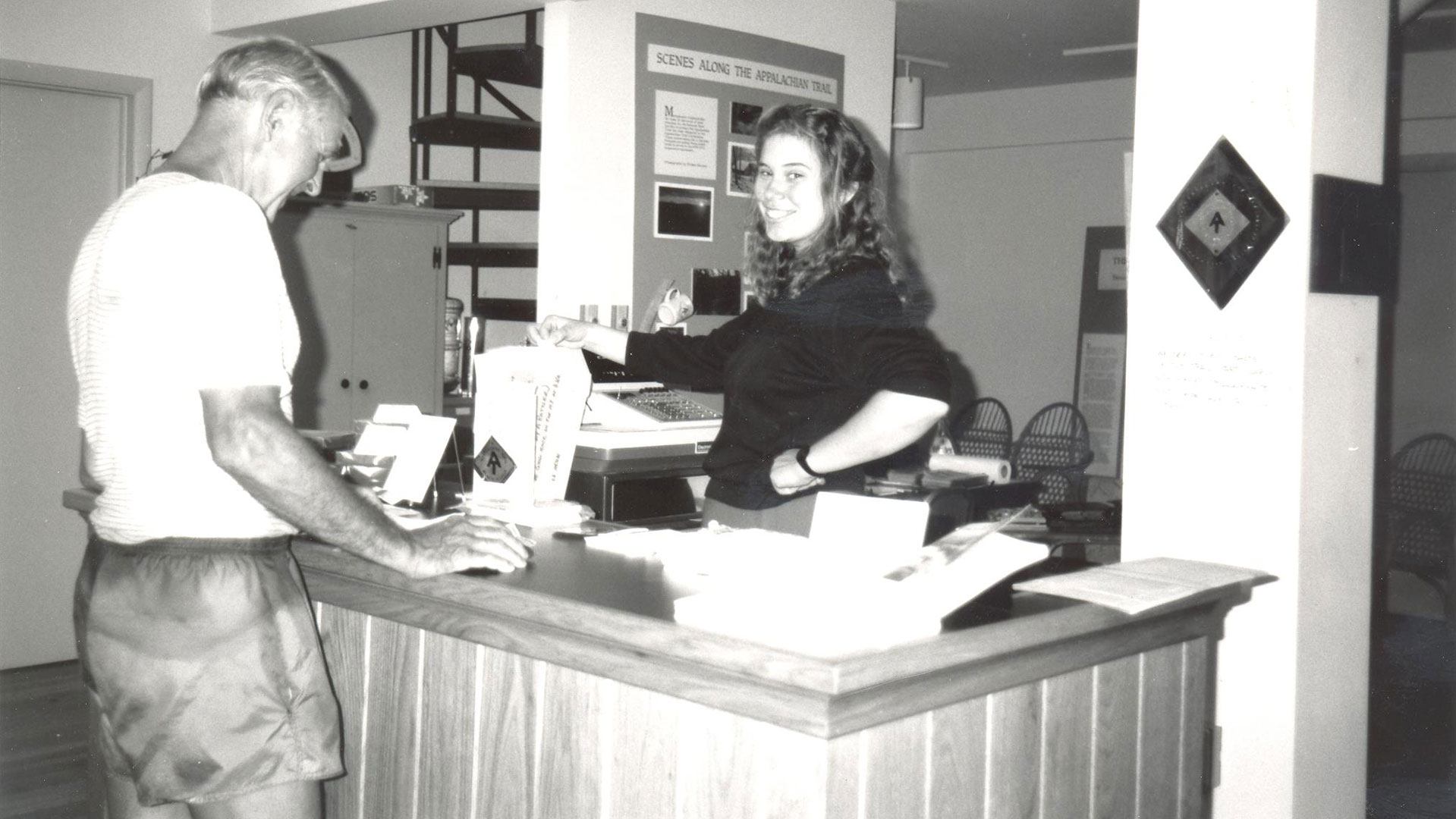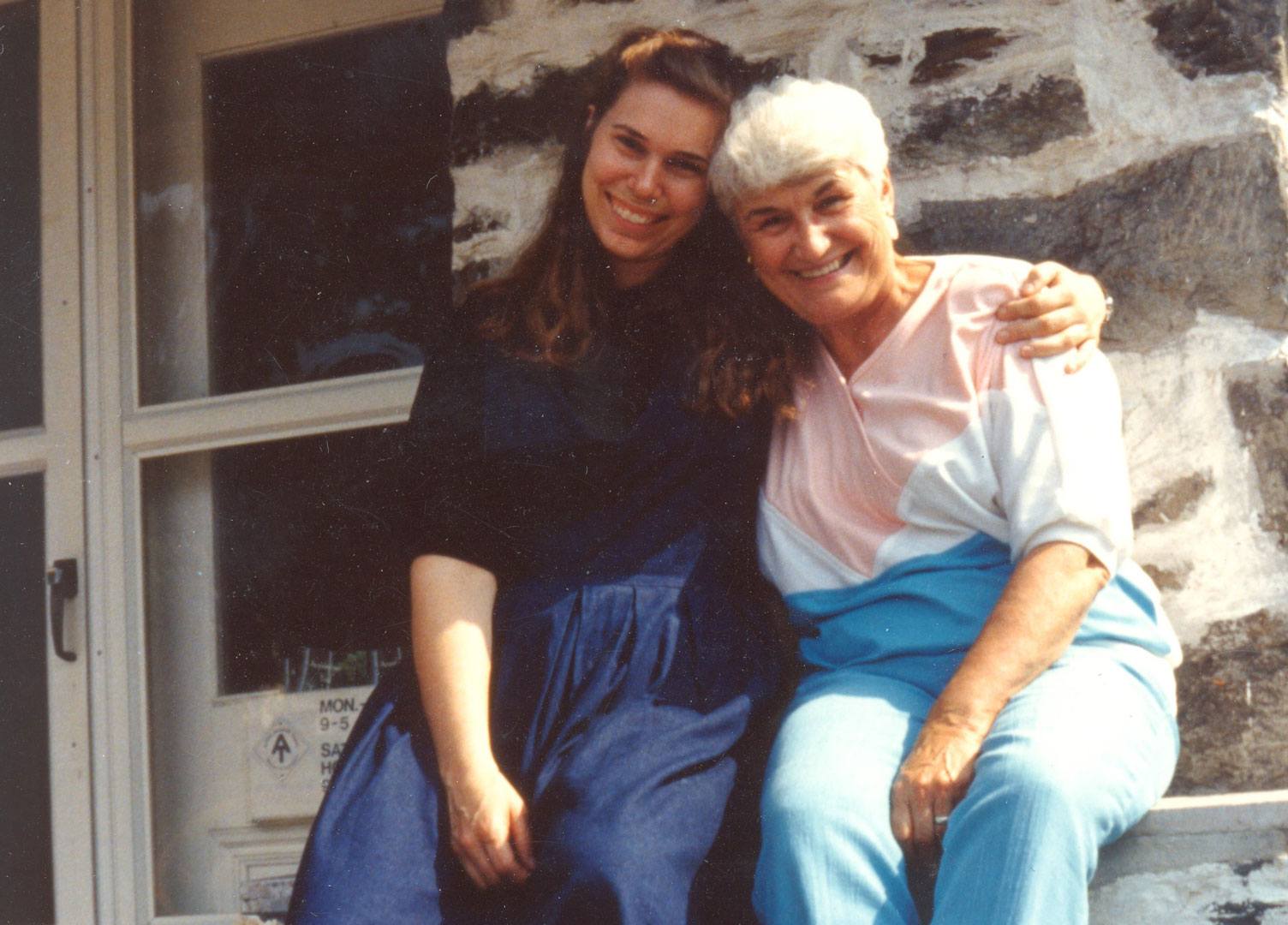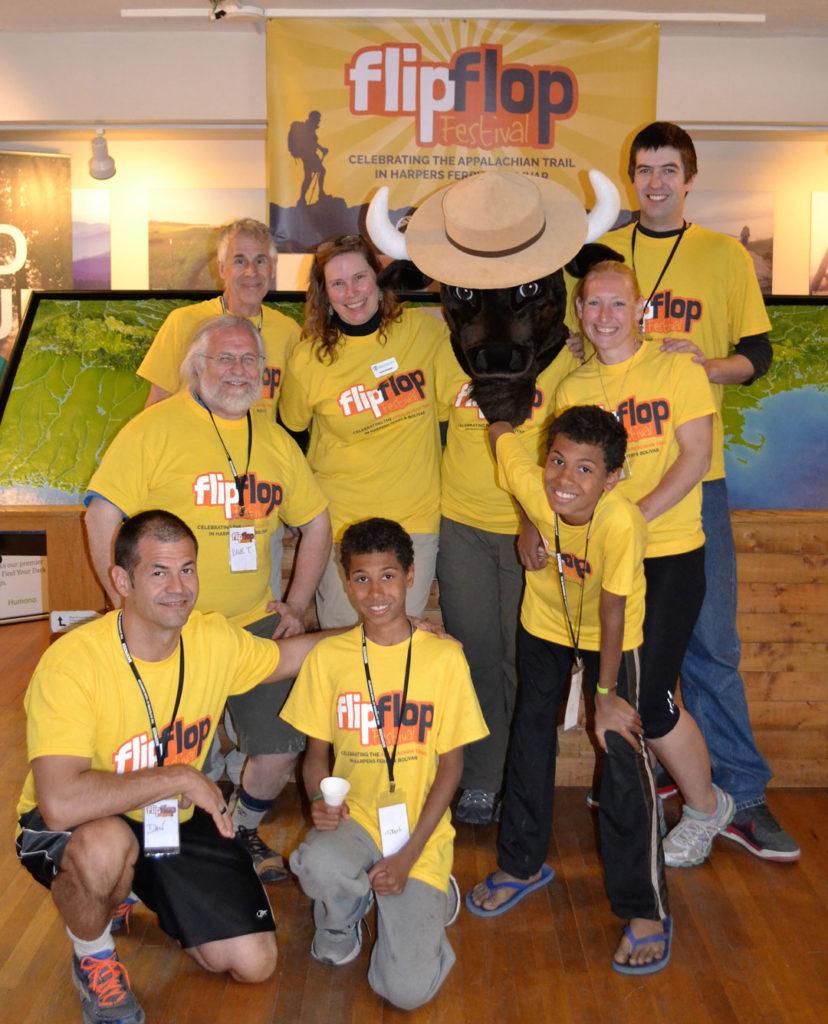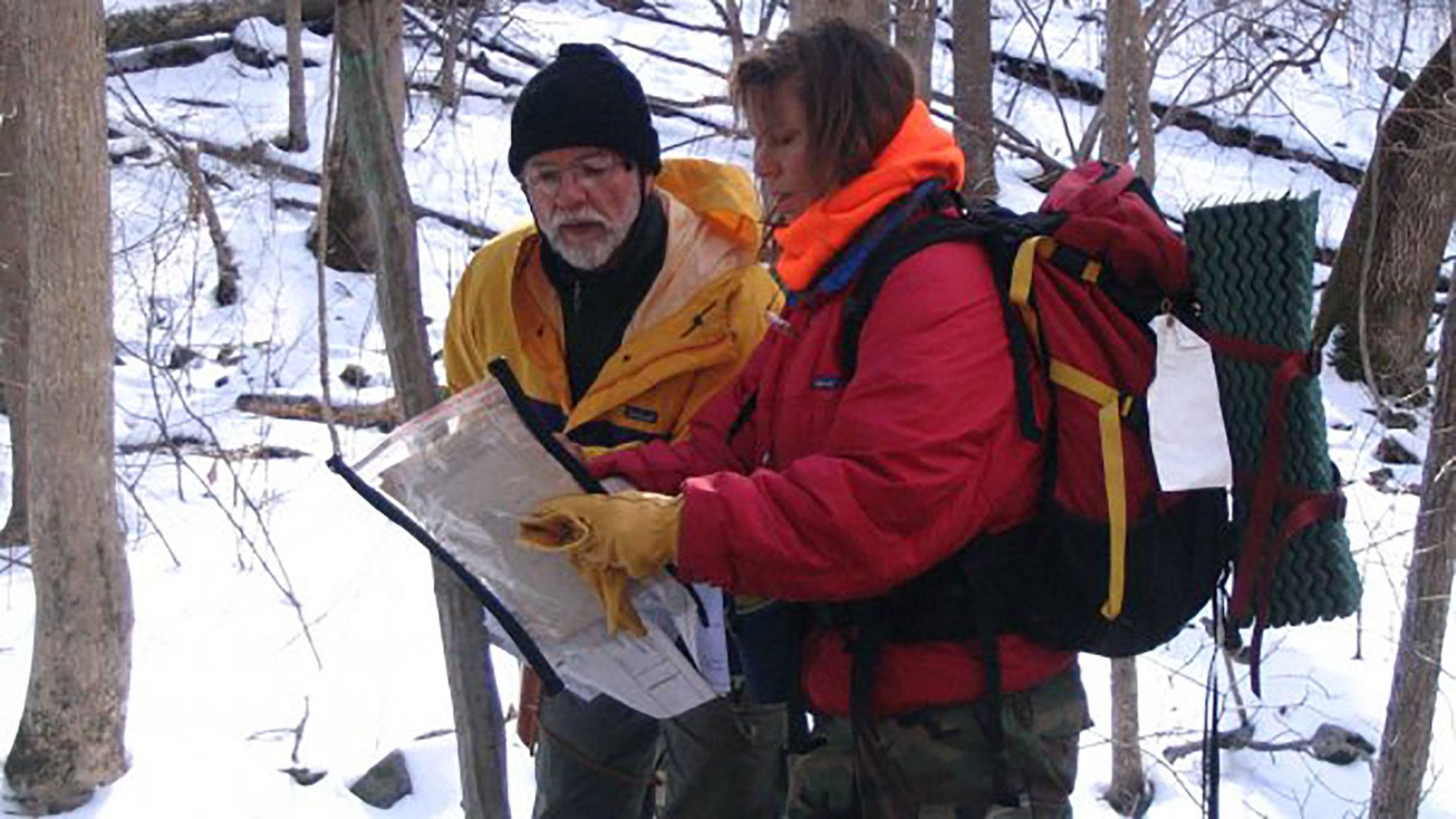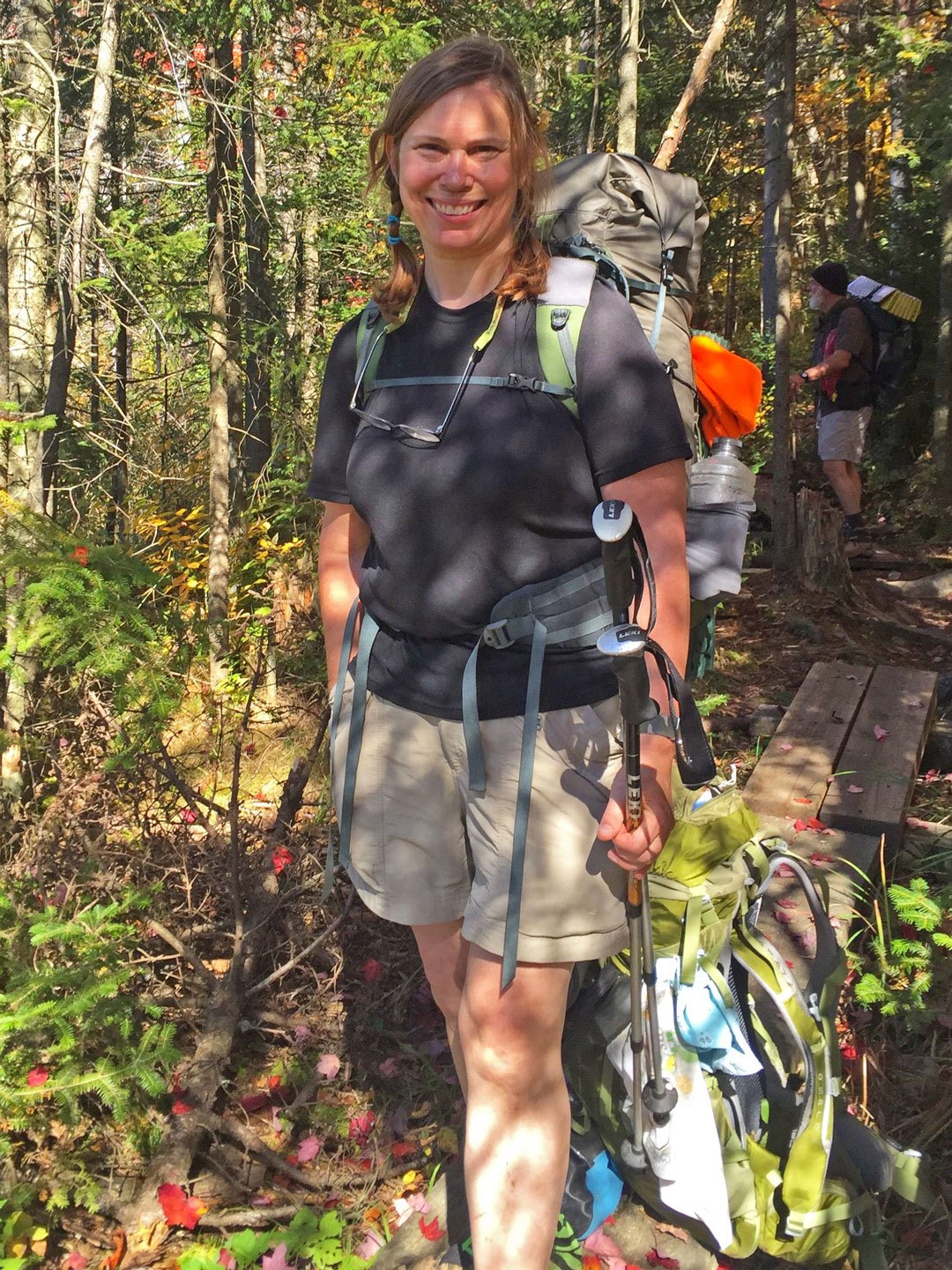By Laurie Potteiger
See You Down the Trail
June 4, 2021
A few days ago, I snapped what may be the last photo I will take of a hiker, in front of the Appalachian Trail Conservancy (ATC) headquarters’ iconic wooden sign, in the capacity of an ATC employee. It’s a role I’ve been immensely proud to fill for 33 years, but it is time for me to move on. As I write this, my retirement is just days away, and I have been reflecting on my journey with the ATC: how I got here, what I’ve learned, changes that have taken place, and what I am taking away with me.
Thirty-five years ago, an ancient, obscure symbol scrawled on a chalkboard transformed my life in an instant. I was on the cusp of leaving the classrooms of academia and about to venture out on a new path in life, with no clue what direction that would be. When the professor wrote a letter from the alphabet of Old Church Slavonic on the wall — which looks uncannily like the symbol for the Appalachian Trail (A.T.) — I was reminded of my long-forgotten teen-aged dream of hiking the Trail. All those years of studying Russian novels went out the window, and I was ready for a different course.
Desperate for guidance that would unlock the secrets held by those lucky enough to complete the six-month sojourn through nature and the American countryside, I placed an ad in the Potomac Appalachian Trail Club’s (PATC) newsletter. Back then, information about hiking the A.T. in its entirety was hard to find.
A couple of months after placing my ad, I met up with a slim, bespeckled, not-particularly-athletic-looking guy who had hiked the A.T. a few years prior who went by the Trail name “E.T.” He gave me two pieces of advice that set me on a path that not only helped get me from Georgia to Maine but brought me a rich and meaningful life:
- One: Join the ATC, then known as the Appalachian Trail Conference.
- Two: Make a pilgrimage to the ATC headquarters in Harpers Ferry, West Virginia, and volunteer.
Growing up, I was intimately familiar with the PATC, but I had never heard of the ATC. My father had been a Trail maintainer, and my favorite family vacations were spent in the rustic log cabins overseen by the club near the A.T. I enthusiastically followed E.T.’s advice, joined the ATC, and made arrangements to volunteer at its office in Harpers Ferry. When my day of volunteering came, my tool of service was an intricate writing instrument known as a “typewriter” — some readers might still know what that is. My assignment is long forgotten, but I did not forget my supervisor’s ear-catching mention of a job that might open for someone with my office skills the following year.
Mostly for fun, but also to increase my Trail karma and boost my résumé in hopes of a future Trail job, I also volunteered on a PATC work trip in the months before starting my thru-hike. Volunteering on the A.T. helped me to develop a newfound kinship with the Trail and an immense sense of gratitude to the Trail Club volunteers whose dedication and hard work would make my journey possible.
In quiet moments walking through the forest by myself, I would sometimes wonder, “What exactly are those ATC people in Harpers Ferry doing in those offices upstairs?” The hard work and devotion of Trail Club volunteers were clear: piles of sawdust and the freshly cut ends of a blown-down tree blocking the Trail; the slanting line of protruding rocks across the Trail, like an unsuccessfully buried stegosaurus, to divert water and reduce erosion; and fresh white rectangles painted on trees to guide hikers from Georgia to Maine. These are all very tangible, understandable evidence of the Trail maintainers’ work. As for the ATC folks, I knew they were busy people in Harpers Ferry doing important work — but what?
Even if I didn’t understand it, I wanted to be a part of the work that was making my experience possible. I sent postcards along the way to the volunteer supervisor I met in the office. “I’m still out here. Don’t forget about me when that job comes open,” I would remind him.
A year later, just four months after ending my transformative six-month journey, I became one of those busy workers at the ATC when I applied for and was chosen for the entry-level job, enraptured to be in the world that revolved around the A.T., day in, day out. The bulk of my days were spent taking phone orders for guidebooks, t-shirts, and A.T. paraphernalia, and then entering those orders into a computer. I loved it.
The ATC was the center of the A.T. universe as well as my personal universe, the place dedicated to the preservation and protection of the Trail — not just in this stretch or that piece, but the whole of it. It was a place where threats to the Trail were wrestled and subdued, not with muscle, sledgehammers, and picks or blustery aggression, but with phone calls, meetings, issue papers, discussion, thoughtful and sincere listening. I saw that words, both spoken and written, were the Trail’s most powerful guardians. I witnessed the methodical development of policies in partnership with Trail volunteers, the National Park Service, the U.S. Forest Service, and so many other A.T. land-managing agencies. I learned about all the intangible things that created, protected, and preserved the Trail. A lot of it was constructs in people’s heads, pieces of paper, and, later, digital documents that influenced, guided, or required the actions of people, organizations, and governments, on and off the Trail. Laws acts, memoranda of understanding, policies, cooperative agreements — those are as vital to the A.T. as the footpath and forests of the Trail.
In the office, I also learned about programs run by the ATC that I had not been aware of when I hiked the Trail. Sometimes my work also allowed me to engage with these programs on the ground — as when I participated in ridgerunner orientations and learned how much could be accomplished when multiple partners worked closely together. When I learned about the ATC’s Trail Crews, with names like Konnarock, Rocky Top and S.W.E.A.T., led by professional trail builders aided by volunteers, the work sounded so exciting that I took vacation time to gain first-hand experience with them. Moving rocks to build stone staircases, splitting giant slabs of rocks with a mix of power and hand tools, and swinging pick mattocks to build new trail gave me a deeper appreciation of what even an office worker like me could contribute to the A.T. as a volunteer.
My very favorite part of that first job as an orders clerk, though, was talking to hikers, providing information, guidance, and support. When hikers ordered maps and guidebooks by phone and would have questions about the hike they were planning, I’d have a chance to “talk trail”— and get paid for it.
In 1996, the ATC’s legendary Jean Cashin announced she was ready to retire from her position as information specialist — a position that led to her being affectionately and reverentially known as “Trail Mom” by generations of hikers, and, for many, the face of the ATC. I applied for Jean’s vacated role with a mix of anticipation and anxiety, knowing that Jean’s boots would be impossible to fill. But I doubt anyone was more eager for the job, and, since I had been Jean’s understudy for the previous eight years, I was offered the job as information services manager in April 1996.
My fitness for the position was tested before I had even gotten my “trail legs” in my new role. The most famous person ever to attempt a thru-hike, Bill Bryson, decided to pay a visit to the ATC in Harpers Ferry unannounced and interview whoever sat behind the front desk: me.
When Bryson’s best-selling travelogue about his adventures, A Walk in the Woods, was published two years later, it led to a keen interest in the A.T. by a wide range of readers and a dramatic increase in Trail use, especially by aspiring thru-hikers. Loved by many (though equally disliked by some in the A.T. community), the book continues to be impactful, and many non-hikers come in just to see what he saw.
Whether readers inspired by his book to hike the A.T. actually mimicked the actions portrayed of himself and his hiking companion in the book — like flinging coffee filters into the woods to jettison weight — I was doubtful. Surely his comical portrait of himself and his buddy as spectacularly unprepared dufus greenhorns would inspire future hikers to do the opposite? Either way, it didn’t do Leave No Trace adherence any favors when he said he proudly declined the recommended purchase of an orange trowel, fearing that being seen with one would signal to more experienced hikers, as he put it in the book, “Make way for Mr. Buttercup.”
So, a self-appointed trowel ambassador I became. With glee, I bought all available backpacking trowels on the market, memorized their weights, and touted the benefits of carrying one to anyone who would listen.
Why such an obsession? A backpacking trowel is one piece of gear you might be carrying that is not only immediately useful to you, but also indicates you care about other people and their experience on the Trail. This choice indicates a willingness to take a little extra effort to avoid the spread of disease, avoid contaminating water sources, and ensure the memories of other people’s journeys are not tarnished by encountering your unburied poop. The pinnacle of happiness for me was taking a photo of a hiker who had a trowel hanging off their pack, capturing that trowel in their official ATC Harpers Ferry hiker photo for the world to see.
Taking a Leave No Trace Master Educator course led me to think out of the box to protect our wild places while enhancing the visitors’ experience. An outcome of that course was to promote a then-rare style of thru-hiking: a continuous journey of the entire Trail starting somewhere in the middle, as opposed to the southern (or northern) terminus. I knew of only a few hikers who had taken this unconventional approach for their own individual reasons. They had found it offered the benefits of starting in easier terrain and milder weather. This itinerary also avoids the crowded conditions at the Trail’s southern end (and avoided contributing to them) while offering a quieter, more nature-focused hike. If these hikers could forego the famed finale on Katahdin — if the journey was more important to them than the destination — this version had a lot going for it.
Promoting flip-flop thru-hikes has since become an integral part of the ATC’s efforts to conserve the A.T. by reducing impacts by dispersing use. An annual Flip Flop Festival started by the ATC and now run primarily by dedicated volunteers with the Trail & Town Alliance of Harpers Ferry and Bolivar has become a highly anticipated event. The number of thru-hikers starting in the middle of the Trail has grown from single digits per year to hundreds. This alternative thru-hike itinerary not only expands the type of experiences available to hikers and reduces crowding; it also gives businesses located in A.T. communities a steadier flow of hikers rather than a mad crush in a narrow window of time.
Helping promote flip-flop thru-hiking was a role I fell in love with, but some aspects of the ATC’s work have been so fascinating and exciting that they gripped me and spilled into my personal life.
“Come walk the line,” I was told by a fellow ATC employee, whose passion for protecting the A.T. corridor was infectious. The way she said it had the charisma of a Johnny Cash hit and immediately made me feel like I was missing out by not participating in the work in the field. Her reference to “the line” was her nickname for the A.T.’s exterior corridor boundary, which defines the outside edges of National Park Service (NPS) lands acquired to provide a permanent, protective buffer for the A.T. footpath and the work of monitoring and maintaining those boundaries. Her colorful call to action to learn about a vitally important but often overlooked aspect of the ATC’s work was part invitation, part playful taunt that I could not refuse. She took my husband and me out “on the line” for a day, and we were completely hooked. We learned how long-standing “witness trees” signal the location of A.T. survey monuments, and how following yellow paint markings on trees allows you to walk an invisible boundary line to monitor for encroachments threatening the Trail and its protected corridor. Before long, we had claimed eight miles of A.T. NPS boundary as “ours” to proudly monitor and maintain, in addition to the section of the A.T. footpath we adopted decades ago.
Some evolutions during my time at the ATC were controversial. Perhaps the one that sticks out most in my mind happened primarily behind the scenes: the turmoil when NPS announced that certification would be required of all volunteers who wanted to use a chainsaw, regardless of whether they’d been sawing their entire lives. There was a great deal of pushback. At least one longtime maintainer quit his volunteer duties in protest. When I learned that the certification was essentially about ensuring that volunteers sawed as safely as possible, it emboldened me to learn to use a chainsaw so I could get certified to use one on the section of Trail my husband and I maintained as volunteers.
Looking back, I remember that the ATC’s new directions have sometimes been misunderstood. Decades ago, when ATC Executive Director Dave Startzell entered into talks with the Access Board to learn how the A.T. could be made more accessible to people with disabilities, there was fear that the Trail would be paved with switchbacks from Georgia to Maine. Decades later, there are in fact fewer miles of the A.T. on pavement due to the combined efforts of the ATC, NPS, Trail Club volunteers, and other partners’ efforts to move the A.T. off roads. Now, half a dozen or so stunningly beautiful sections of the A.T. have been modified to be wheelchair accessible; none are paved. I hope there will be more accessible sections.
Changing the name of the ATC in 2005 from “Appalachian Trail Conference” to “Appalachian Trail Conservancy” was in retrospect overdue, but fraught with controversy at the time. Likewise, the ATC’s voluntary thru-hiker registration (now known as ATCamp) was initially met with some skepticism and mistrust. The online, real-time charts of registered thru-hike start dates are now recognized as a useful tool that enables hikers to spread themselves out and reduce — or avoid — crowding.
But hearing the worries, complaints, and support from both our direct partners and the A.T. hiking community was essential, and one of the parts of my job I loved the most. Working in the ATC’s Harpers Ferry Visitor Center, I learned that every hiker — every person — has a story, if you just give them an opportunity to tell it. This is true in life, too, but something about the A.T. enables people to be their most authentic selves and be more open to sharing who they are. Over the years, I have met thousands of hikers, and I wish I could tell you the stories of them all.
Almost all who know me would say that the A.T. has been my life’s passion, but life on this Earth is finite. My time has come to retire from the ATC.
As the decades have gone by and I don’t have the stamina I once had, I started hearing from my husband when I would come home, spent from the day’s work, “I am not getting the best part of you.” I only needed to hear that a few times before I asked the ATC human resources department if I could switch my position to part-time. The day I started as a part-time employee two years ago, my beloved twin brother had a test that revealed he had pancreatic cancer — the same disease that had taken my father ten years earlier — with just months to live. The timing of my reduced hours was fortuitous: it allowed me to spend those precious last months with him — which, of course, included a visit to the A.T.
I find that even being part-time has not given me enough time with my husband — who, by the way, I first met when he was my volunteer supervisor at the ATC those 35 long years ago. There are too many things left to do, like completing our section-hikes of the A.T., joining him to do my proper share of our A.T. and boundary maintenance, and spending time at our log cabin in the woods not far from the A.T., nurturing native plants and keeping invasive exotic plants at bay.
Although the A.T. will still be a big part of my life, my husband, my family, and my brother’s friends are now the center of my universe. Among my friends, I now count many of the extraordinary volunteers with whom I worked side-by-side in the ATC Harpers Ferry Visitor Center for many years.
Some Trail magic is happening as I write this. A young woman named Kayla Carter — a recent thru-hiker, Tennessee Eastman Hiking and Canoeing Club Trail maintainer, and ATC volunteer who is deeply passionate about conserving and celebrating the Trail — is coming into the job of Information Services Manager. Through her combined professional and volunteer work, she has developed many of the skills and experience it took me an entire career to build. I’m excited for her, and I’m excited for the ATC.
Today, information about the A.T. is not hard to find. A Google search for “Appalachian Trail” yields 18 million results. What continues to be needed, however, is information about enjoying the A.T. in ways that conserve the footpath, the corridor, and the heart-pounding and soul-inspiring vistas, as well as the connected lands that help preserve the quiet, the biodiversity of plants and animals, the wildness, and the soul-inspiring vistas — with beauty as far as the eye can see — so they are parts of America forever. That is a role the ATC has filled and will continue to fill, and as I look back, I am happy to have been a part of what it has become.


